

Deep Learning Trends: top 20 best uses of GPT-3 by OpenAI. I wrote a post about the uses of GPT-3 a few days ago to be specific just 10 days ago but the number of interesting developments using the GPT-3 API are so much that I could not stop myself from writing another post showing some awesome developments using the GPT-3 API.
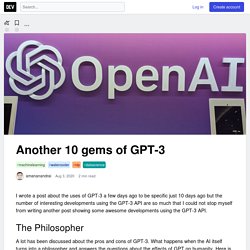
A lot has been discussed about the pros and cons of GPT-3. What happens when the AI itself turns into a philosopher and answers the questions about the effects of GPT on humanity. Here is an example where the GPT-3 writes an essay explaining itself to humanity and how it will affect humankind. What will happen when Machine Learning models start writing Machine learning models. It sounds like the story of a Sci-fi movie, but it's a reality now GPT-3 can write ML models for specific datasets and tasks.
AI INCEPTION! OpenLearn (Free Learning from the Open University) Designing Impactful Learning. Jednoduchý e-learningový nástroj. All our free courses. 2019's Most Popular Online Courses (100 courses) - List by Dhawal Shah. By The Numbers: MOOCs in 2019. Now in its eighth year, the modern MOOC movement has reached 110 million learners, excluding China1.
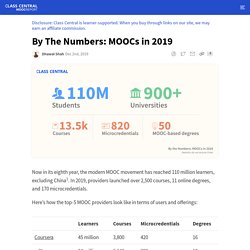
In 2019, providers launched over 2,500 courses, 11 online degrees, and 170 microcredentials. Here’s how the top-5 MOOC providers look like in terms of users and offerings: For Class Central‘s complete analysis keep reading. For our previous years’ analyses, follow the links: Courses By the end of 2019, 13.5K MOOCs have been announced or launched by over 900 universities around the world. Online Degrees In 2018, we saw the top MOOC providers announce a large number of degrees: 30 overall! I called this the second wave of MOOC Hype and 2018, the year of MOOC-based of degrees. But in 2019, only 11 new degrees were announced, most by Coursera and FutureLearn. Interestingly, a MOOC-based degree seems to have been either canceled or postponed: edX’s Data Science Master — offered by the University of California, San Diego — isn’t listed on the provider’s page anymore. Coursera's 2019: Year in Review.
The total number of registered learners on the platform grew from 37 million to 45 million, allowing Coursera to remain the world’s largest MOOC provider by a significant margin.
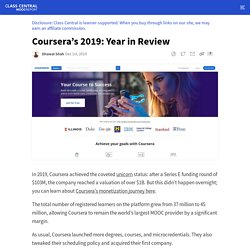
As usual, Coursera launched more degrees, courses, and microcredentials. They also tweaked their scheduling policy and acquired their first company. How to MOOC? – A pedagogical guideline for practitioners. Catalog : Catcat. Guest post: Biggest eLearning content trends of 2020 and beyond. If we go by Training Magazine’s prediction about the eLearning industry, it will be safe to say that Online learning is not a small industry anymore.
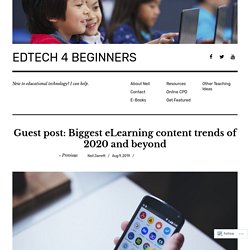
In fact, expected to grow at a compounded annual growth rate of 5% between 2019 and 2024 and expected to cross the $200 billion mark by 2024. Learning through a virtual medium has become highly popular over the last decade. Be it for basic education or for corporate or medical training, technology has made its place in among people as a reliable form of learning and development. And as the time progressing in every scientifically, the learning (rather, eLearning) community is witnessing substantial changes in the ways that education has been adopted till now.
Normal, subjective content has long left the field and now is the time to instill interactiveness in your courses. All our free courses. How to Create an eLearning Course in 12 Steps. Looking at all the things that are involved in creating an eLearning course could make you feel like your first step should be to “Give Up.”

However, with these 12 steps, we break down the process into manageable chunks, which is a big part of what makes for good eLearning course design. Not so bad, right? Read through these steps, and soon you’ll have a good handle on what is needed and where to start to create your first eLearning courses. Contrary to popular belief, deciding “we need eLearning because everyone else is doing it” is not really the first step to start. What Are Some of the Biggest Challenges eLearning Professionals Face? All over the world, eLearning professionals are tossing and turning in their beds.

They’re waking up in cold sweats, muttering things about ‘compatibility’ and ‘M-Learning’. The constant winds of change are taking their toll on our psyches. We couldn’t let you suffer in silence any longer. So we set out to do some research and find out what’s playing on your minds. We all know that training has shifted, shifted, and shifted again.
We decided that to tackle these problems effectively; we have to prioritize. We asked: They answered (these are the top answers): Getting our SME's to buy into the instructional design process.Style guides and consistency (being consistent in the visual design of the course).Keeping learning fresh and engagement high.Nobody is doing the ANALYSIS phase.Too much content! Free PowerPoint Template: Conversation Interaction. Here’s a free PowerPoint template I built for a recent workshop.
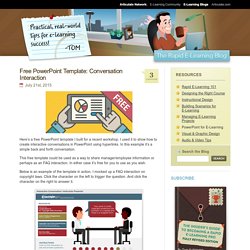
I used it to show how to create interactive conversations in PowerPoint using hyperlinks. In this example it’s a simple back and forth conversation. This free template could be used as a way to share manager/employee information or perhaps as an FAQ interaction. In either case it’s free for you to use as you wish. Below is an example of the template in action.
Click here to see the free template demo. Articulate E-Learning Heroes Community. Stanford Medicine 25. Pedagogical Aspect(s) of Online and Distance Learning. “When It Comes to Paying Users, the Completion Rate Is Pretty High” Have MOOCs Become Something People Love to Hate?

Class-Central’s Dhawal Shah in Conversation By Henry Kronk | IBL News In the fall semester of 2011, Stanford University Professors Sebastien Thrun and Peter Norvig launched one of the first of a new generation of massive open online courses (MOOCs) on artificial intelligence. Dhawal Shah signed up for his course. Within that fall semester, more and more MOOCs were launched. Henry Kronk: Many publications have declared recently that MOOCs have failed to live up to their promise. Best of 2018: Most Downloaded PowerPoint Freebies. Best of 2018: Most Helpful Instructional Design Resources.